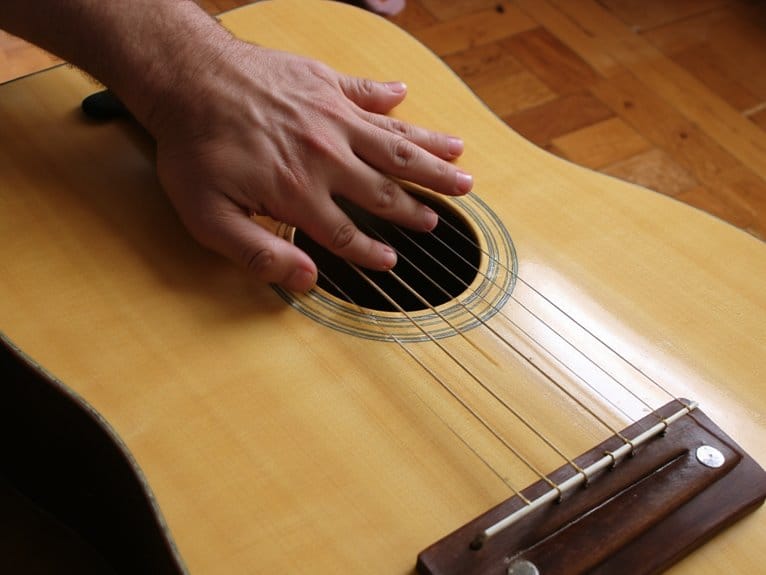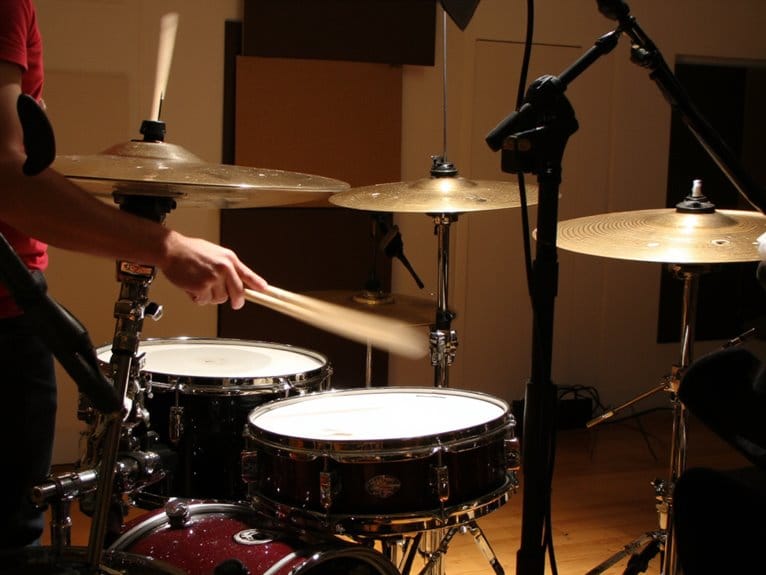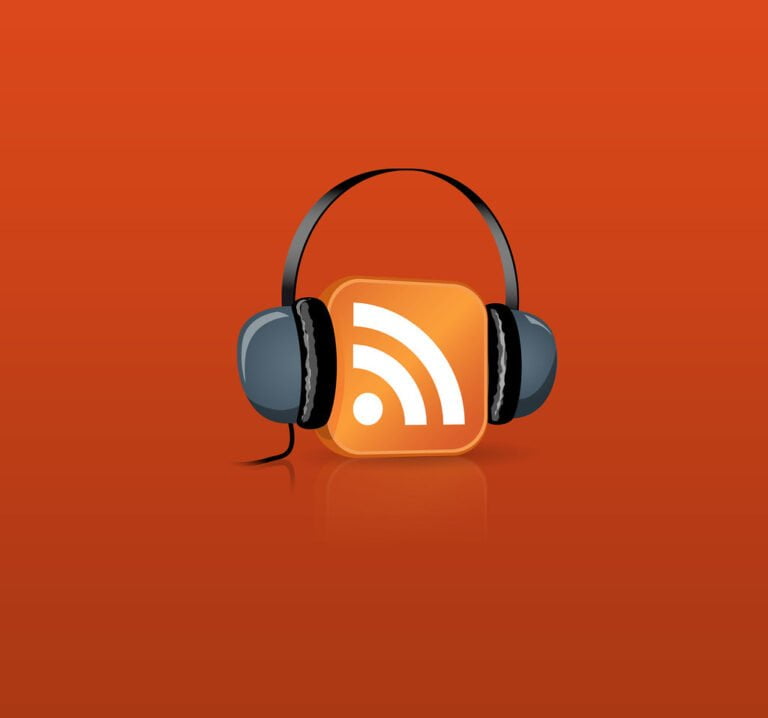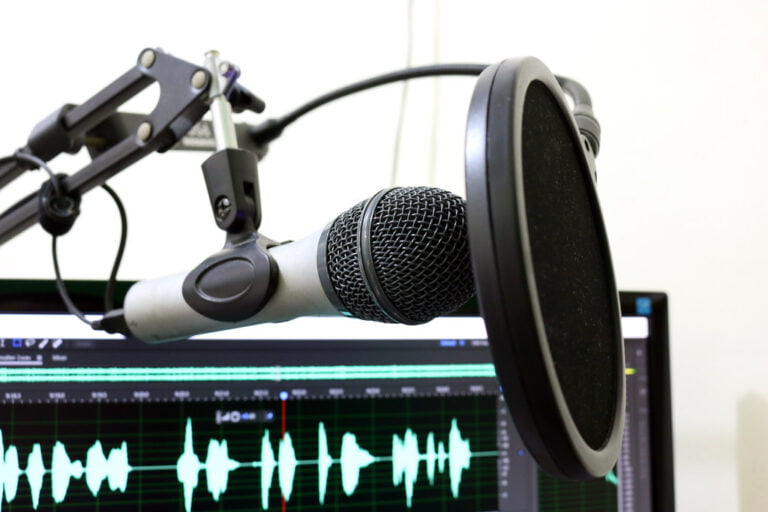Understanding Guitar Tablature Vs Standard Notation
Guitar tablature provides instant visual feedback by showing you exactly which frets to press on each string, making it perfect for beginners who want quick results without learning traditional music theory. Standard notation, however, offers thorough musical information including rhythm, dynamics, and universal communication across all instruments, though it requires more initial study time. While TAB gets you playing songs faster, standard notation builds extensive musicianship skills that’ll release advanced techniques, collaboration opportunities, and deeper musical understanding as you progress.
We are supported by our audience. When you purchase through links on our site, we may earn an affiliate commission, at no extra cost for you. Learn more.
Notable Insights
- TAB shows exact fret positions on guitar strings while standard notation displays universal pitch and rhythm information.
- TAB offers faster learning for beginners through visual finger placement but lacks timing and rhythmic details.
- Standard notation provides complete musical information including dynamics, key signatures, and note durations for professional communication.
- TAB works best for rock and blues genres while standard notation is essential for classical and jazz collaboration.
- Successful guitarists use both systems strategically depending on their musical goals and playing contexts.
Key Differences Between TAB and Standard Notation Systems
When I first started learning guitar, I’ll admit I was drawn to tablature because it seemed so much easier than those intimidating five-line staffs I’d seen in piano books.
However, understanding the fundamental differences between these two notation systems has become essential for any guitarist who wants to communicate effectively with other musicians.
Tab usability shines in its direct string-to-fret mapping, where numbers on six lines correspond exactly to your guitar’s physical layout, making finger placement immediately obvious.
However, notation complexity in standard music includes rhythmic information, dynamics, and performance techniques that TAB typically omits, which explains why your learning preferences might favor one system depending on whether you’re focused on quick song reproduction or in-depth musical understanding.
One particularly confusing aspect arises because guitars allow you to play the same pitch at multiple fret locations across different strings, which standard notation cannot specify, leaving guitarists to determine the optimal fingering position themselves.
Additionally, standard notation serves as a universal communication tool that enables musicians across different instruments and genres to collaborate seamlessly.
Learning Curves and Accessibility for Guitar Students
Although I’ve watched countless students tackle both notation systems over the years, the reality is that your choice between TAB and standard notation will greatly impact how quickly you’ll progress and what musical doors will open for you down the road.
TAB clearly wins for immediate gratification, since its six-line visual representation mirrors your guitar strings perfectly, allowing you to place fingers without understanding pitch relationships or music theory. Most beginner preferences lean heavily toward TAB because it accommodates different learning styles, particularly visual learners who struggle with abstract notation concepts.
However, while TAB gets you playing songs faster, standard notation builds thorough musicianship skills that’ll serve you better long-term, especially if you plan to collaborate with other musicians or pursue formal education. The major drawback is that TAB provides no rhythm information, forcing players to rely on recordings or memory to maintain proper timing.
Musical Information and Detail Comparison
Beyond the learning curve considerations, the actual musical information each system provides reveals stark differences that’ll shape your understanding of music itself. Standard notation delivers extensive musical detail including rhythmic values, dynamics, and articulation marks, while tabs focus primarily on finger placement without timing specifics.
| Musical Element | Standard Notation | Guitar Tabs |
|---|---|---|
| Rhythmic Values | Explicit note durations | Usually absent |
| Musical Theory | Key signatures, intervals | Minimal theory cues |
| Dynamics | Volume markings included | Not represented |
| Pitch Information | Universal pitch notation | Fret positions only |
| Harmonic Context | Shows chord relationships | Physical placement focus |
You’ll find that standard notation supports deeper musical theory understanding, revealing harmonic progressions and melodic patterns that tabs simply can’t convey through their fret-position format.
Practical Applications in Different Musical Contexts
While musical understanding forms the foundation, your choice between tablature and standard notation ultimately depends on the practical situations you’ll encounter as a guitarist.
Your notation choice should align with your playing goals and the musical contexts where you’ll actually use these skills.
If you’re diving into rock, metal, or blues where specific guitar techniques and fretboard positioning matter most, tablature becomes your go-to resource for learning riffs and solos quickly.
However, when you’re collaborating with other musicians or tackling classical and jazz pieces, standard notation serves as the universal language that transcends instrument-specific limitations.
Your notation preferences will naturally evolve based on your musical goals:
- Jamming with a band requires standard notation for seamless communication across instruments
- Learning popular songs benefits from tablature’s intuitive fret-number system for immediate playability
- Studio sessions demand standard notation’s thorough details for professional accuracy and timing precision
Making the Right Choice for Your Musical Journey
How do you navigate the choice between tablature and standard notation when your musical aspirations pull you in different directions? Your musical preferences and personal goals should drive this decision, though I’ve learned that flexibility often trumps rigid adherence to one system.
If you’re focused on quickly learning songs and building confidence, TAB offers immediate gratification without theoretical baggage. However, if your personal goals include formal education, composition, or collaboration with other musicians, standard notation becomes indispensable.
Consider your timeline too—hobbyists seeking fast repertoire acquisition benefit from TAB’s accessibility, while those pursuing long-term development need standard notation’s thorough foundation.
Most successful guitarists eventually embrace both systems, using each tool strategically based on specific musical contexts and collaborative requirements.
Frequently Asked Questions
Can Guitar Tablature Be Converted to Standard Notation Using Software?
You can absolutely convert guitar tablature to standard notation using guitar software like TablEdit, Guitar Pro, and MuseScore. These programs offer seamless notation conversion with linked staves and maintain timing accuracy throughout the process.
Which Notation System Is Better for Memorizing Guitar Solos Long-Term?
You’ll memorize solos better long-term using standard notation because it strengthens visual memory of musical patterns and enhances auditory recall through rhythmic context, while tabs only develop finger muscle memory without deeper understanding.
On a final note
Whether you’re strumming campfire songs or tackling complex jazz pieces, you’ll eventually need both notation systems in your musical toolkit. I’ve found that starting with tablature gets you playing faster, but standard notation reveals deeper musical understanding and communication with other musicians. Don’t stress about choosing sides—embrace both formats based on your goals, musical style, and learning preferences for maximum guitar development.






